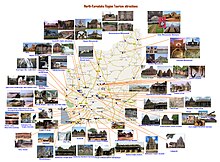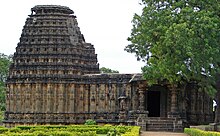Karnataka, the eighth largest state in India has been ranked as the fifth most popular state in the country for tourism.[1][2] [3] It is home to 507 of the 3600 centrally protected monuments in India, the largest number after Uttar Pradesh.[4] The State Directorate of Archaeology and Museums protects an additional 752 monuments and another 25,000 monuments are yet to receive protection.[5] Tourism centres on the ancient sculptured temples, modern cities, the hill ranges, forests and beaches. Broadly, tourism in Karnatakacan be divided into four geographical regions: North Karnataka, the Hill Stations, Coastal Karnataka and South Karnataka.
The Karnataka Government has recently introduced The Golden Chariot – a train which connects popular tourist destinations in the state and Goa.
North Karnataka
North Karnataka has monuments that date back to the 5th century. Kannadaempires that ruled the Deccan had their capitals here. Badami Chalukyasmonuments are located at Pattadakal,Aihole and Badami. Aihole has been called the cradle of Indian architecture[6]and has over 125 temples and monuments built between 450 and 1100 BC. Rashtrakuta monuments at Lokapura, Bilgi and Kuknur and Kalyani Chalukyas monuments built in Gadag style of architecture[7][8] at Lakkundi,Gadag, Itagi (in Koppal District) and theVijayanagar empire temples atVijayanagara are some examples.Hampi in Bellary District has ruins spread over an area of 125 km². With some fifty four world heritage monuments and six hundred and fifty national monuments (ASI). An additional three hundred monuments await protection. The Deccan sultanate monuments at Bijapur and Gulbargashow unique and discreet Hindu influences and rival the Muslim monuments of North India. Archeologically important locations likeSannati, Kanaganahalli in Gulbarga district have thrown more light onBuddhist centres of the 1st century BCE to 3rd century CE. The first ever statue of emperor Ashoka with his queens and a Prakrit inscription Rayo Ashoka (ASI) has been found.
Badami surroundings important locations are Kudalasangama, Aihole,Pattadakal, Mahakuta and Banashankari.
World heritage centres
- Hampi, Bellary District:[9] The site of the capital of Vijayanagara (1336) and formerly the seat of the Vijayanagar Empire. Foreign visitors in the 15th and 16th centuries described Hampi as being bigger than Rome. The city was destroyed and deserted in 1565 by marauding Moghul invaders and its ruins now lie scattered over a 26 sq. km area south of the river Tungabhadra. The rocky area near Anegundi to the north of the river has been identified asKishkindha of Ramayanatimes.[citation needed] Hampi is home to a 29-foot-tall (8.8 m) monolithicNarasimha, which was installed byKrishnadevaraya in 1529. The remains of palaces and gateways can be seen.
- Group of 8th-century CE monuments,Pattadakal:[10] Located on the banks of the river Malaprabha, Pattadakal was the second capital of the Chalukyas and contains examples of 7th- and 8th-century temple architecture. Four temples are in the south IndianDravidian style, four in the North IndianNagara style and the last one, the Papanatha temple represents a hybrid of the two styles. The oldest temples are the Sangameshwara, Mallikarjuna and Virupaksha Temples.
Historical locations
Western Chalukya
- Aihole:[11] a former Chalukya trading city. There are around 140 temples including examples of early Chalukya,Rashtrakuta and later Chalukya dynasties from the 6th to 12th centuries. It has a Jain and Vedic rock-cut shrine, both of about the 6th century. It has Tirthankara images and a Durga temple. The meguti on a hill is a jaina basti which has an Aihole inscription of Pulikeshin 2 and also a Buddhist two-storied rock -cut shrine below it. All the other Jain and Buddhist temples are built of stone and resemble Hindu temples. The temples were built during the Middle Ages before any style was established and hence there is a mixture of styles.
- Badami:[12][13] the capital of the early Chalukyas in the 6th century, is at the mouth of a ravine between two rocky hills. The town is known for its cave temples (all carved out of sandstone hills). Badami have four caves, the cave temple dedicated to Vishnu is the largest. In front of the cave temple, there is a reservoir called Aghastya Teertha dotted with temples on its bank. Among them, two are dedicated to Vishnu, one to Shiva and the fourth is a Jain Temple. Carvings in the cave temples display the Hindu gods, Narashima and Hari Hara. The temples also have paintings on the ceiling and bracket figures on the piers.
- Basavana Bagewadi: It is 43 east of Bijapur. In the 12th century, SaintBasaveshwara was born here. It was an agrahara. The main temple here is in the Chalukya style and it was called as Sangamantha in records. The Samadhis of Siddharameshwara and Gurupadeshwara of the Inchageri school of spiritual pursuit are seen here.
- Basavakalyana,[14] Bidar District: former capital of the Later Chalukyas. It has an old fort renovated by theBahamani containing an Archaeological Museum. Few Chalukya or Kalachuri remains exist except the Chalukya Narayanapur temple in the outskirts of the town. There is a modern Basaveshwara temple, Prabhudevara Gadduge, Jurist of the Kalyani Chalukyas period. Vijnaneshwara's Cave, Madivala Machiah's Pond, Akka Nagamma's Cave, fully renovated Siddheshwara temple and a new structure called Anubhava Mantapa, the Qaji's mosque and Raja Bagh Sawar Dargah.
- Annigeri (30 km from Hubli): It has an Amriteshwara temple of the time of theKalyani Chalukyas. It was the birthplace of great Kannada Poet Pampa and there is a Jain basadi of Parshwanatha. It was once a headquarters of Belvola-300. It was the capital of ChalukyaSomeshwara 4. In addition to Veerashaiva Mathas; there is a ruined Banashankari Temple and seven mosques and also an ancient Veerabhadra temple.
- Bankapura (80 km from Dharwad): Under Chalukya many temples were raised in the city including the Nagareshwara temple in the fort and another chalukya temple called Siddheshwara. Ali Adilshahi destroyed many temples in about 1567. There is a mosque in the fort.
- Dambal (21 km from Gadag): It was a Buddhist centre. There are two notable chalukya temples called Doddabasappa Temple and Somewshwara Temple. Doddabassapa as polygonal star shaped temple garbhagriha and fine sculptural representations and huge nandi Temple. Someshwara could have been an old basati. The temple has a 400-year-old vast tank. There is an old Ganapathi image in old ruined fort. And we can also find a huge Ganapathi image in a small shrine.
Contd.... Part II









No comments:
Post a Comment